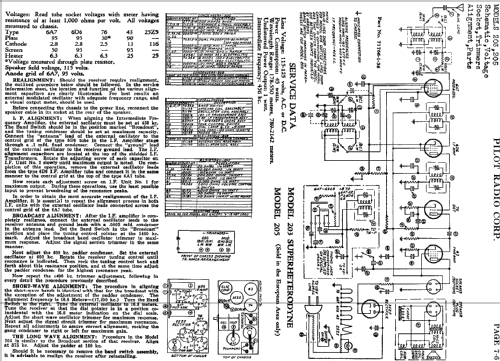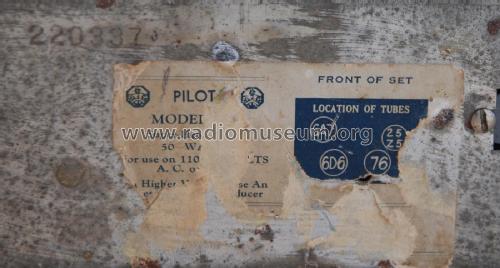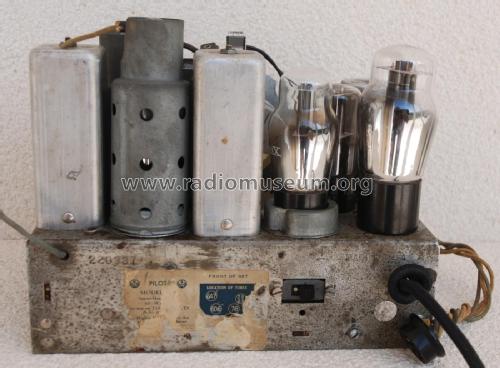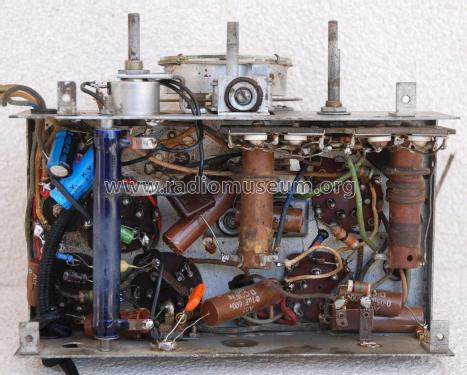- Pays
- Etats-Unis
- Fabricant / Marque
- Pilot Electric Mfg. Co. (Radio Corp.); Brooklyn (NY)
- Année
- 1936
- Catégorie
- Radio - ou tuner d'après la guerre 1939-45
- Radiomuseum.org ID
- 51776
-
- alternative name: Pilot Radio & Television || Pilot Radio and Tube || Pilot Radio Corporation
Cliquez sur la vignette du schéma pour le demander en tant que document gratuit.
- No. de tubes
- 5
- Principe général
- Super hétérodyne (en général); FI/IF 456 kHz
- Circuits accordés
- 6 Circuits MA (AM)
- Gammes d'ondes
- PO et OC
- Particularités
- Tourne disque / changeur (châssis)
- Tension / type courant
- Appareil tous courants (CA / CC) / 110 Volt
- Haut-parleur
- HP dynamique à électro-aimant (électrodynamique) / Ø 5 inch = 12.7 cm
- Puissance de sortie
- 1 W (qualité inconnue)
- Matière
- Boitier en bakélite
- De Radiomuseum.org
- Modèle: 203 [76 tube] - Pilot Electric Mfg. Co. Radio
- Forme
- Modèle de table vertical décoré (pierre tombale)
- Dimensions (LHP)
- 237 x 320 x 180 mm / 9.3 x 12.6 x 7.1 inch
- Remarques
- This tube lineup is well documented in Riders. Nevertheless there are definitely models using a 75 tube (see there).
- Poids net
- 3.5 kg / 7 lb 11.3 oz (7.709 lb)
- Source extérieure
- Ernst Erb
- Source du schéma
- Rider's Perpetual, Volume 7 = 1936 and before
- D'autres Modèles
-
Vous pourrez trouver sous ce lien 544 modèles d'appareils, 273 avec des images et 412 avec des schémas.
Tous les appareils de Pilot Electric Mfg. Co. (Radio Corp.); Brooklyn (NY)
Collections
Le modèle 203 fait partie des collections des membres suivants.
Contributions du forum pour ce modèle: Pilot Electric Mfg.: 203
Discussions: 4 | Publications: 6
To get optimum search I put the obvious identical models 203 (75 tube) and X203 together. Now both ways to search will arrive at the model "203 (X203)". And the model with 76 tube is also clearly defined.
To use early and late would not help. A collector looking for info in RM would never find such a hint on his radio. In our case here the tubes are unambiguous means to discriminate.
In addition "early" and "late" as found in some Sylvania Service notes are in doubt insofar, as both versions are noted for the same year 1936 (Riders vs. Machine Age).
Konrad Birkner † 12.08.2014, 19.May.07
Gentlemen,
First of all: I would like to limit this research action to models of identical appearance as there are 203, 205, X203, X205 (and still candid ones, who knows).
Pilot caused a mess here: The label is for an X203 (for USA).They forgot to stamp an X in front of the number. The European version would be the X205. These models are using the 75 and a 25L6.<br>The 203 (without X) is the US model, its European version is the 205. These models use a 76 and a 43.
The label pictured at 203 shows a combination of 75 and 43, and it says 115 Volt but the set is for 220-240 Volts.
Are there other variations known? I need to know: tube lineup, mains, wavebands, labelling.
Please mail, that I can collect info, sort out and create variants, when as much info as possible will be available.
Please no precipitate actions. Corrections are more time consuming than a complete tidying action.
Thanks
Konrad Birkner † 12.08.2014, 14.Feb.07
Here it is the Ivory version, kindly sent by Mr. António Manuel dos Santos from Coimbra-Portugal.
It is already uploaded in this model's tread.
Thank you Mr. António.
Mario Coelho, 27.Aug.05
Dear Friends
I've now one USA Pilot model 203
http://www.radiomuseum.org/dsp_modell.cfm?model_id=51776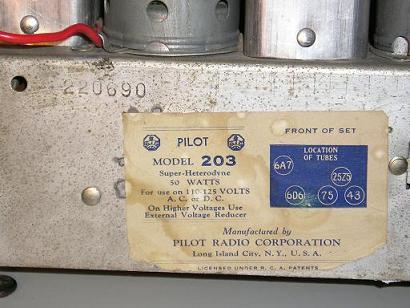
As You can see it was made in USA. It is written in its label on chassis.
Its tubes are 6A7; 6D6;75 (not 76*); 43 and 25Z5.
* Not 76 as you can see in http://www.nostalgiaair.org/Resources/309/T0000309.htm but is very clear 75 in its label.
So I think this option (tube 75) might be considered in observations.
Thank you for your time
Mário Coelho
Mario Coelho, 05.Mar.05
